Introduction
Port Sudan lies on the Red Sea coast in the Red Sea State of eastern Sudan. It serves as the country’s commercial and maritime capital. The city has a semi-desert climate characterized by scarce rainfall and a reliance on maritime transport, with limited local water production through desalination from the Arba’at Valley and desalination plants. The city was established in 1909 as a modern port during the Anglo-Egyptian period, Port Sudan was built from scratch to serve as Sudan’s gateway to the global trade network via the Red Sea.
Environment and Historical Tourism
Port Sudan has long been a gateway for eco-tourism, offering pristine beaches, warm waters, and coral reef diving. The tourism sector contributed around 2.4% of the GDP in 2019, with 591,000 international tourists recorded in 2013, compared to only 29,000 visitors in 1995. This indicates gradual growth despite fluctuations in security conditions.
Beja Culture and Urban Composition
The Beja communities, the indigenous inhabitants of the region, constitute more than 65% of Red Sea State’s population, which was about 1.48 million in 2018, with a significant concentration in Port Sudan. The Beja, who speak the Cushitic Beja (Bedawiyet) language, have traditionally lived by herding, fishing, and engaging in ancient trade. Their cultural presence is still evident in neighborhoods such as Deim Al-Arab and Umm Al-Husani, where family ties and community networks remain strong despite urban changes.

Beja tribes: Source: Nafisa Habib
Urban Architecture and City Character
Port Sudan’s architectural landscape displays a mix of modern structures that have emerged in the city’s central areas and the traditional Beja-style buildings made of mud and straw in the older neighborhoods. Traditional districts, especially Deim Al-Arab, are characterized by low, two-story houses of simple design, featuring flat roofs that reflect adaptation to the region’s arid desert environment.

The arid desert ecosystem in Arkwit, Port Sudan. Source: Sudan in Photo
Impact of War, Tourism Collapse, and Urban Transformation
Since the outbreak of war in April 2023 between the Sudanese Armed Forces and the Rapid Support Forces, Port Sudan has undergone profound transformations on multiple levels. The number of international tourists has dropped to less than 15% of pre-war levels; in 2019, the city received around 600,000 visitors annually, but by mid-2024, almost all international flights to Port Sudan had ceased. As a result, more than 70% of hotels and tourism facilities in the city were forced to close.
Demographically, Port Sudan has received over 550,000 internally displaced people (IDPs) from conflict-affected regions such as Khartoum and Darfur by early 2025, increasing the city’s population from roughly 420,000 before the war to nearly 970,000. This influx placed immense pressure on health, education, and infrastructure services. Reports indicate that 60% of schools and hospitals in Port Sudan suffer from severe resource shortages, while unemployment has risen above 40% among both local residents and displaced populations.
Economically, the GDP of the Red Sea State declined by 35% in 2024 compared to 2022, driven by sharp drops in revenue from tourism and maritime trade following disruptions at the main port and the suspension of many commercial activities. The war also disrupted traditional trading practices long relied upon by the local Beja communities, deepening poverty and marginalization in older neighborhoods such as Deim Al-Arab and Umm Al-Husani.
On the humanitarian level, the United Nations has described the situation in Port Sudan as a severe humanitarian crisis, marked by acute shortages of food and safe drinking water, with over 55% of households facing extreme food insecurity. Additionally, drone airstrikes on the city in May 2025 further disrupted electricity and airport operations, complicating the delivery of humanitarian aid.
These developments collectively illustrate the collapse of the tourism sector and Port Sudan’s transformation from a thriving commercial and tourist hub into a refuge for displaced people, giving rise to a new demographic reality and posing profound challenges for the city’s future development.
Local Tourism: A Realistic Opportunity Amid Collapse
After two years of devastating war in Sudan, international tourism has come to a complete halt. Yet, domestic tourism in Port Sudan has emerged as a practical option for both economic and social survival, despite the country’s ongoing crises. Amid internal displacement and population pressure, many locals and displaced families have turned to traveling within the country as a temporary refuge for rest and sustenance.
According to a report by the Sudanese Tourism Authority, the Red Sea coastal areas, especially Port Sudan and Suakin, have become major destinations for domestic tourism, attracting visitors not only from Khartoum but from various Sudanese states. This is particularly true during the winter season, when the weather is mild and the beaches are clean, with diverse coral reefs. Through the annual Shopping and Tourism Festival organized in the Red Sea State, the number of local visitors reached several thousand at peak season (around 3,000–4,000 domestic and Arab Gulf tourists in 2023), providing a temporary pulse of economic activity.
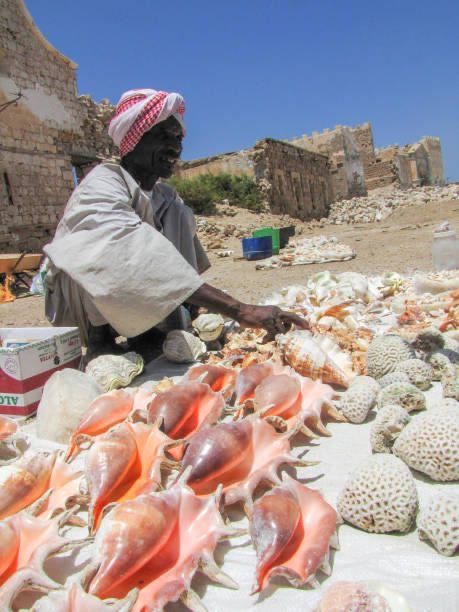
A man selling seashells and coral in the heart of Suakin. Source: iStock Photo
The estimated population of over 500,000 who came to Port Sudan from other parts of the country, displaced by conflict, mostly concentrated their activity around markets, cafés, and the seafront, suddenly revitalizing local economic life amid the downturn in port and industrial operations. Although these visitors did not come to the city as tourists per se, but rather seeking refuge or transit, this influx has generated what some call “burnt tourism”—a form of internal tourism that isn’t driven by leisure, yet still stimulates activity across small hotels, markets, and eateries.
Patterns of local consumption have doubled: apartment rents, for example, rose from 300,000 Sudanese pounds to over one million per month, whether for hotel-style rentals or temporary shelters like schools and mosques. Many families have started sharing rooms or staying in mosques due to the shortage of formal housing.
This new dynamic has begun to outline the features of a new phase. Despite official collapse, Port Sudan has evolved into a cluster of local travel, where real economic activity outweighs the sudden inflation in demand. Such a return to domestic tourism, even if born of necessity, could later form fertile ground for developing sustainable programs in eco-tourism, cultural tourism, or community-based tourism, if properly organized and directed. This is especially viable once security stabilizes and organizational, governmental, or international support for domestic tourism becomes available.
Top Tourist Attractions in Port Sudan
Diving Reserves and Coral Reefs: An Underwater Paradise
Sanganeb Marine National Park
Located about 25 km northeast of Port Sudan, Sanganeb Marine National Park was declared Sudan’s first official marine reserve in 1990 and remains one of the most spectacular diving sites in the Red Sea. It is the only atoll-shaped reef in the entire Red Sea, encompassing at least 13 distinct ecological zones, with coral walls plunging to depths of up to 800 meters, offering divers breathtaking underwater vistas.
The reserve boasts an extraordinarily rich ecosystem, with over 120 species of coral and around 250–300 species of reef fish, including hammerhead sharks, dolphins, sea turtles, and a variety of rare and migratory species. It is also home to one of the last regional populations of the endangered dugong (the endangered marine species of the Red Sea), found within its shared protected area with the Dungonab Bay.
A notable historical landmark for visitors is the Sanganeb Lighthouse, built by the British between 1958 and 1964. Standing 50–54 meters tall with 268 steps, it can be visited through prior arrangement with diving operators. From the top, visitors enjoy sweeping views of the turquoise coral waters and surrounding atoll formations.

Sanganeb Coral Lighthouse near Port Sudan, on the Red Sea, in Sanganeb National Park. Source: I Stock Photo
In 2016, Sanganeb Marine National Park and Dungonab Bay, Mukawar Island, were jointly inscribed on the UNESCO World Heritage List, recognized under criteria (vii), (ix), and (x) for their outstanding natural beauty, ecological processes, and biodiversity conservation. For diving enthusiasts and eco-tourism travelers, visiting Sanganeb is an unforgettable encounter with one of the purest marine environments on Earth.
Dungonab Bay and Rumi Reef
Forming part of the same UNESCO World Heritage Site, the Dungonab Bay–Mukawar Island Marine Reserve, complements Sanganeb with its mix of coral reefs, marine savannas, and endangered mangrove forests. The area is renowned as a key habitat for dugongs, and as a nesting and feeding ground for migratory birds such as flamingos and pink pelicans, as well as rare species of reef fish and unique landscapes.
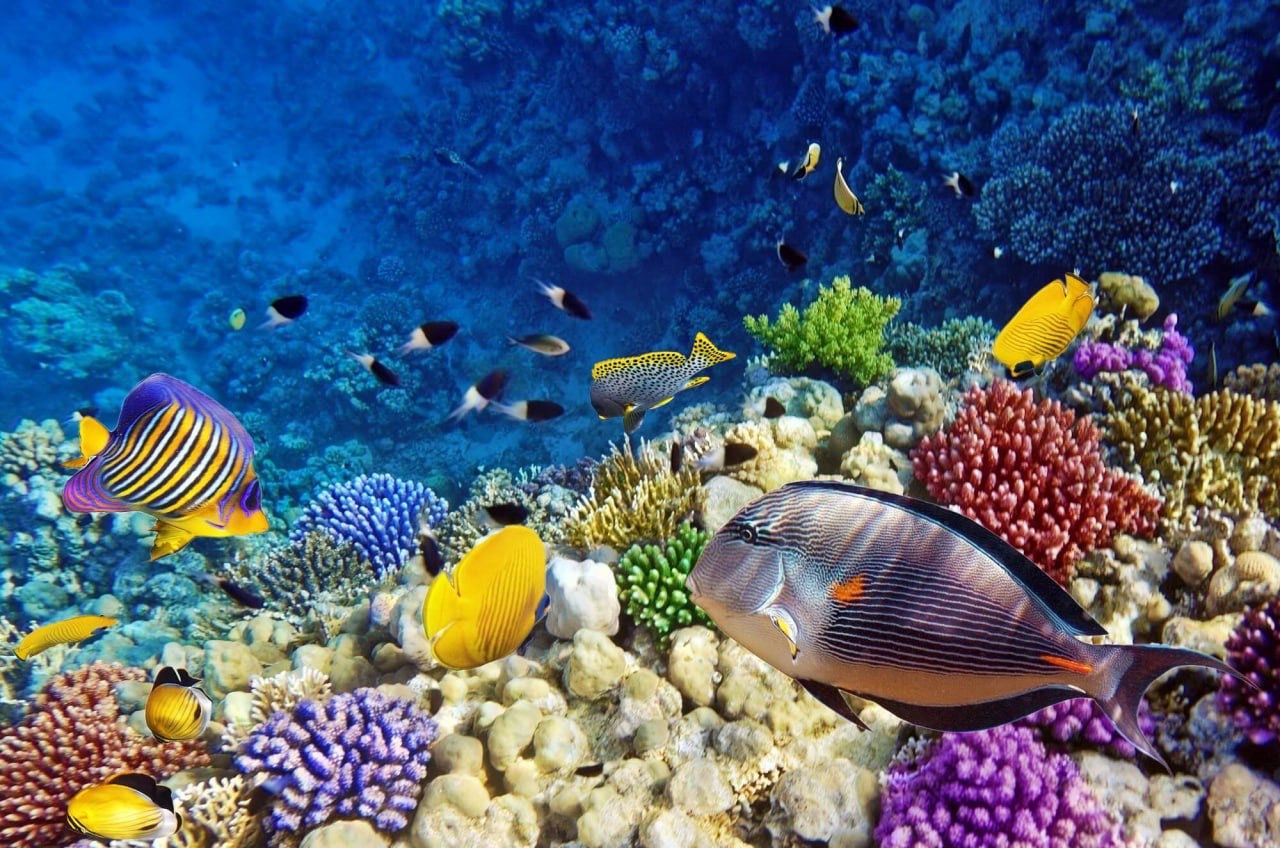
The coral reefs and colorful fish for which the shores of Port Sudan are famous. Source: Noon Post Magazine
Islands of History and Natural Beauty
Suakin Island
Suakin Island lies off Sudan’s eastern Red Sea coast and stands as a prominent historical and archaeological site dating back to the medieval and Ottoman eras. Once a thriving coastal city of commerce and faith, it served as a key transit point for pilgrims and traders moving between Africa and al-Hijaz.
Among its most notable landmarks is the historic Suakin Mosque, built from coral stone, embodying both the Ottoman-Islamic architectural style and the island’s maritime trading heritage. In addition, the island is home to a number of schools, zawiyas (Sufi lodges), and khalwas (traditional Quranic schools) distinguished by their unique design- living testaments to the enduring connection between past and present through the continuation of Suakin’s rich religious and social traditions.

The historic Suakin Mosque, built from coral stone. Source: iStock Photo
Natural Parks and Resorts
Arkwit Resort
Arkwit Resort, a mountain retreat situated at an elevation of 1,000–1,200 meters near Port Sudan, is a breathtaking natural haven for those who love cool mountain breezes and elevated landscapes, a welcome escape from the coastal heat. Surrounded by wooded hills and captivating desert terrain, it is often described as “God’s paradise in Sudan” by nature enthusiasts and photographers alike.
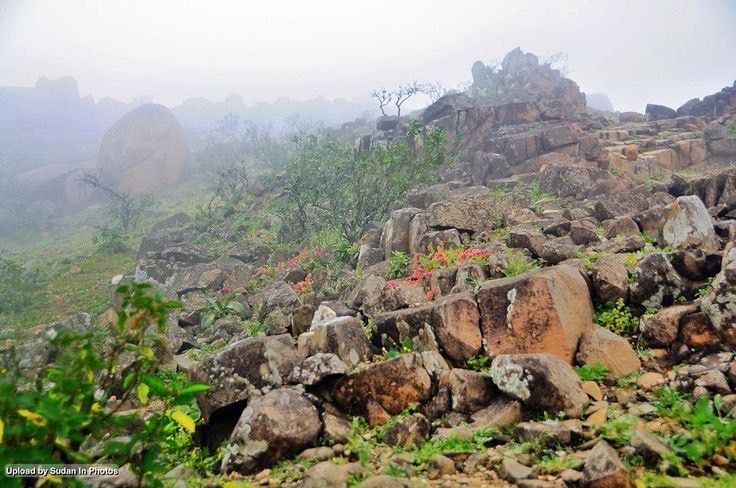
Arkwit Port Sudan. Source: Sudan in Photo
Arous Tourist Village
Arous Tourist Village, located on the Red Sea coast north of Port Sudan, is one of Sudan’s most beautiful marine destinations, a place where pristine nature meets layers of mysterious history. The resort is known for its tranquil white beaches and a bay encircled by coral reefs, making it an ideal spot for snorkeling and diving enthusiasts amid rare corals, colorful fish, and crystal-clear waters.
The area offers a simple, eco-style stay experience through beach huts and tents that allow visitors to disconnect from the bustle of city life and immerse themselves in the serenity of the sea. The resort also features a local restaurant serving fresh seafood dishes and a café with relaxed music and an easygoing atmosphere. Evenings often bring a touch of quiet liveliness, reflecting a spirit of freedom and adventure.
Notably, during the 1980s, Arous Resort served as the site of a well-known intelligence operation, when Israeli Mossad agents used it as a fake diving resort to smuggle Ethiopian Jews (the Falasha), a mysterious historical episode that adds to the site’s intrigue. With its rare blend of natural beauty and compelling history, Arous stands out as one of Sudan’s most distinctive and captivating destinations.

Arous Tourist Resort. Source: Seashell Sudan Page
Urban and Cultural Landmarks
Port Sudan Corniche
The Port Sudan Corniche serves as the city’s symbolic waterfront. A golden promenade lined with palm trees that stretches along the Red Sea coast, it offers spectacular views of the sunset and the open horizon. It’s a favorite gathering place for locals, where tea stalls and simple kiosks line the walkways, and evening strolls are accompanied by the gentle sea breeze and the rhythm of everyday Sudanese life.
Port Sudan Maritime Museum
The Maritime Museum, also known as the Red Sea Maritime Museum or Port Sudan Aquarium, is located along the city’s main corniche. Opened in 2014 as a joint initiative between the Faculty of Marine Science and Fisheries at the Red Sea University and the state government, it is the first museum of its kind in Sudan.
The museum showcases a vast collection of marine life, featuring over 300 species of fish and invertebrates, as well as exhibits on marine geology and traditional fishing tools. Future plans aim to expand the collection by approximately 5,000 additional species. Open to the public and official delegations alike, the museum charges a symbolic entrance fee, the proceeds of which go toward developing the facility and maintaining the marine exhibits.
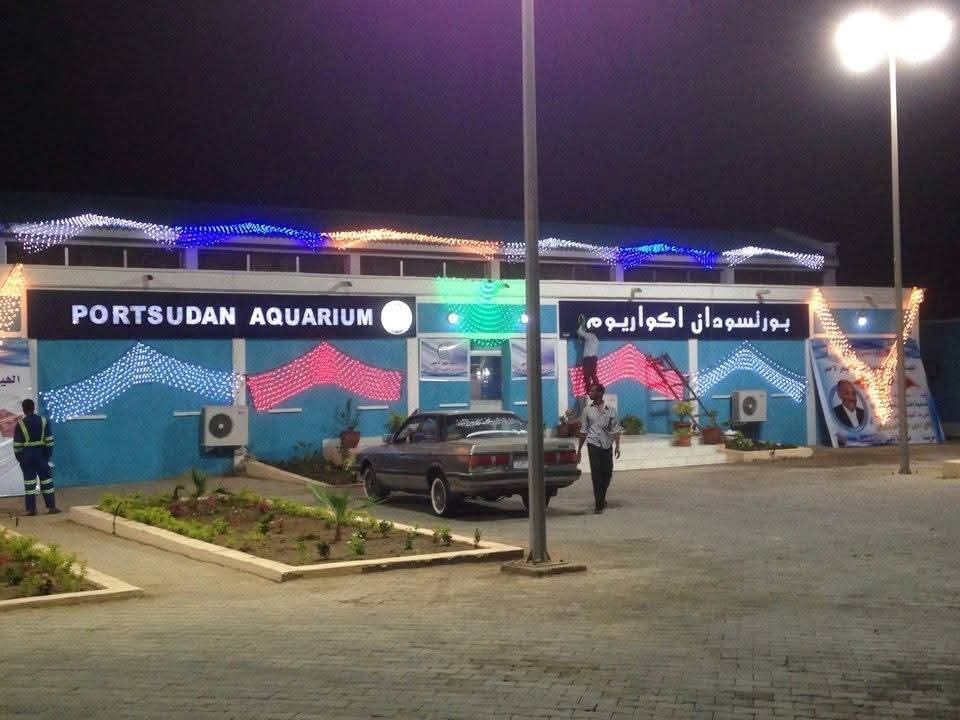
Port Sudan Maritime Museum. Source: Omnia Hassan
Challenges Facing the Revival of Tourism
Port Sudan faces enormous challenges on the road to rebuilding its tourism sector amid deep humanitarian and economic crises, many of which are as severe as the country’s broader national predicament. Social infrastructure, security stability, and the capacity to attract investment are all under unprecedented strain.
First, the comprehensive economic collapse that has struck Sudan. GDP contracted by approximately 40% in 2023, and a further 28% decline is expected in 2024. Government revenues have fallen by about 80%, while hyperinflation has driven prices up by nearly 250%. The Sudanese pound has plummeted in value, with the black-market exchange rate reaching SDG 1,250 per US dollar by February 2024. This crisis has crippled tourism and hotel investments and even halted the import of basic goods.
Second, the crisis in basic services and infrastructure. Due to the war, critical facilities such as the main airport, power stations, and fuel depots were hit by drone strikes in May 2025, resulting in widespread power outages and the temporary suspension of air travel. Over 70% of health facilities in conflict areas have closed, and more than 60% of agricultural land is now unproductive, worsening food insecurity and causing the collapse of essential services.
Third, the humanitarian crisis and internally displaced persons - where Sudan hosts over 8.8 million internally displaced people and an additional 3.5 million refugees abroad, making it the country with the largest internal displacement crisis in the world. Thousands have sought refuge in Port Sudan, where residents face severe pressure on housing, education, and healthcare systems, along with soaring unemployment, poverty, and early marriage rates among displaced girls.
Fourth: The deterioration of the health system and welfare. Mental health issues and the high cost of care have become major obstacles. Even before the war, Sudan had fewer than 34 general psychiatrists and only 4 child specialists nationwide. Today, rates of post-traumatic stress disorder, depression, and anxiety affect about 57% of the population, driven by hunger and prolonged conflict.
Fifth: Institutional fragility and a loss of public trust. Tourism depends on a secure and stable environment, yet Sudan’s international image has been marred by conflict and the looting of antiquities. National museums have lost hundreds of thousands of artifacts, while heritage sites such as Meroe and Naga have suffered attacks and destruction, fueling widespread illicit trade in antiquities.
Sixth: Climate and environmental challenges. In August 2024, the collapse of the Arba’at Dam triggered floods that destroyed around 20 villages near Port Sudan and displaced approximately 50,000 people, causing a severe drinking water crisis for the city, which relies heavily on that reservoir.
All these factors illustrate how the path toward reviving Port Sudan’s tourism image is fraught with structural challenges. Without political stability, improved essential services, infrastructure rehabilitation, and a well-crafted local and global promotion strategy, any attempt to revive the sector will face overwhelming obstacles, regardless of the natural beauty of the beaches that once defined Port Sudan’s identity.
Signs of a Tourism Revival in Port Sudan
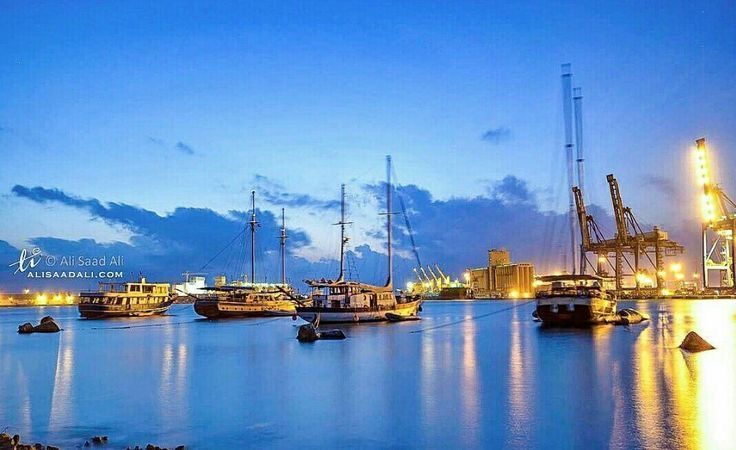
Port Sudan Port. Source: iStock Photo
Despite the devastation left by the war and the sharp decline in tourism activity, local travel companies continue to keep a small flame burning in the darkness, a sign that Port Sudan still possesses the foundations for recovery.
Companies such as Travel Sudan Tours, Real Sudan, and Soviet Tours have played a key role in sustaining the heartbeat of domestic tourism throughout the conflict by organizing diving trips along the Red Sea coast, tours of archaeological sites in Suakin, and promoting cultural and experiential tourism, including visits to local markets, encounters with Beja traditions, and tastings of distinctive seafood dishes.
In addition, the Red Sea Arous Project signed an agreement with the Sovereignty Council and a Kuwaiti real estate company in July 2025. It stands out as one of the most promising ventures that could contribute to the future revival of the tourism sector. The project aims to transform the Red Sea coast into a world-class tourist destination through the development of luxury resorts, yacht marinas, and integrated entertainment facilities, all while preserving the marine environment and the area’s unique biodiversity.
Although its implementation was disrupted by the war, resuming it once stability returns could mark a turning point that restores Port Sudan to the global spotlight, generates broad employment opportunities, and revitalizes the local economy by attracting investment and visitors alike. With growing hopes for an end to the war and the beginning of reconstruction, real opportunities for a tourism revival are emerging, not only in Port Sudan but across the entire country.
Sudan’s unique geographic location, natural diversity, and cultural richness position it well to become a sustainable and thriving travel destination. By making the most of its remaining infrastructure, strengthening community-based tourism, and opening up to new markets, Port Sudan could once again become a gateway of hope, restoring to Sudanese people the belief that what follows the war may, indeed, be something more beautiful.
